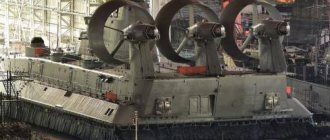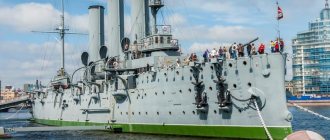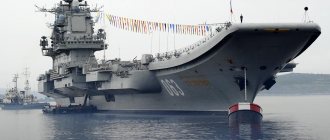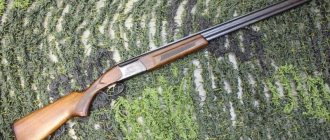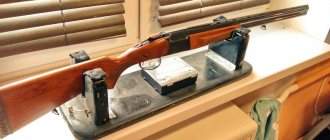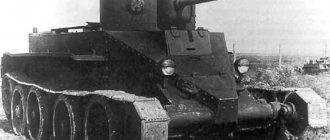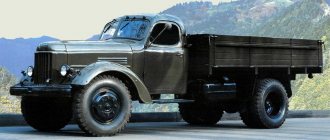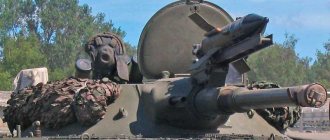The advantage of hovercraft (HFV, SVP) is minimal or no draft. This allows ships to move not only in shallow water, but also on ground or ice, overcoming small areas of land. In addition to the properties of an amphibian, the shallow draft provides the ship with high speed.
The idea of such a design was first voiced at the beginning of the 18th century; technologies for implementation appeared at the end of the 19th century. Prototypes of hovercraft appeared only in the first half of the 20th century. Today, for military purposes, such ships are used for landing, mining, and delivery of cargo and equipment.
Project 12322 “Zubr” is a Soviet small landing hovercraft (MDK, MDVKP). Designed for delivery and evacuation of infantry and equipment from equipped or unequipped shores.
History of the development and creation of the landing ship
SVP "Zubr"
For work on the design of a new hovercraft, Soviet engineers already had sufficient experience. In the early 1970s, the landing boats Skat and Kalmar and the hovercraft Jeyran were in service.
In 1978, TsMKB Almaz received a task to design a more powerful air-cushion landing ship compared to the existing Dzheyran. Project number 12322 was called “Bison”. The emphasis of development was on increasing speed and driving performance, carrying capacity, as well as improving combat and electronic weapons.
Construction of new ships began in 1983. The first prototype MDK-95, which became the lead ship of the series, was assembled in 1986. After all the tests in 1988, these hovercrafts were put into service. Subsequent models were assembled with some modifications taking into account the test results.
By the beginning of the 1990s, there were 8 such ships in the USSR Navy. With the collapse of the USSR, 5 of them went to Russia, 3 to Ukraine, and she was able to collect another one on her own. Russian production of new ships has been suspended and the emphasis has shifted to exports. 4 Zubrs were delivered to Greece. Ukraine collected the same amount for China.
Currently, the Russian Navy has only two hovercraft of Project 12322 - “Mordovia” and “Evgeniy Kocheshkov”. In 2022, the revival of the series was announced; the start of construction of new ships is planned for 2019-21.
How many Zubrs are left?
With all the merits of this wonderful example of the Soviet defense industry, one cannot help but add a fly in the ointment to the glorious ointment that its creators undoubtedly deserve. At the time of the collapse of the USSR, the Black Sea Fleet included eight units of the Zubr airborne landing craft. This brigade of landing ships was not divided equally, but fraternally: Russia received five (among them the first prototype, which can be ignored), and Ukraine received three ships (“Kramatorsk”, “Artemovsk” and “Gorlovka”). Champions of universal justice should not be indignant. The Ukrainian fleet did not need the Zubrs it received; the military budget was unable to maintain them. In addition, two more ships were being completed in Feodosia, one of which was completed. Again, justice requires that we note that the Russian fleet also did not use its Zubrs in the best way. When Greece (a NATO member country!) expressed a desire to purchase unique warships, both Ukraine and Russia offered to buy a couple of each. The deal was completed.
Then the three remaining units were decommissioned from the Ukrainian Navy as unnecessary, and, apparently, cut into scrap metal, for which there is always a demand.
So, in the end, the Greeks have the most “Bisons”, four. The Russian fleet has two units, and China has one, completed at Ukrainian shipyards. By the way, it is planned to build four more copies in China. Ukrainian specialists provided assistance and technical documentation.
As a consolation, we can state that the combat use of “Zubrov” during the Georgian-Abkhaz conflict has so far been the only and successful one. The details of military operations with their participation are unknown to the general public.
Main goals and tasks
The main purpose of Project 12322 ships is to land infantry along with equipment. To achieve this, the Zubr ship is capable of taking on board units from an unequipped shore, transporting them by sea, and overcoming land areas, including small obstacles. Landing can be carried out both on the coastline and further behind enemy lines.
Taking into account the technical characteristics, the Zubr is capable of landing troops on 70% of the coast of all seas and oceans of the world. In addition, the ship is capable of laying minefields, as well as covering landings with existing artillery.
Alternative landing concepts
A vehicle with a wheeled or tracked undercarriage can move on land and overcome difficult obstacles, but the height range of obstacles is limited. There are armored vehicles capable of swimming, but their navigability usually does not correspond to the concept of a “ship”; they are slow-moving and relatively helpless until they enter the shore. There are special-purpose warships designed to transport and land troops, which may include several units of armored vehicles and manpower. These watercraft also have disadvantages: they are vulnerable due to their low speed, and they require a suitable shore to successfully complete a combat mission. Only 14% of all beaches are suitable for landing with water-displacement type MDC (an abbreviation for small landing craft), mooring closely and opening ramps.
There is another concept developed in recent decades. This is an over-the-horizon landing. Its essence is that the main ship is located far from the coast, and the delivery of armored vehicles is carried out by special self-propelled small vessels. The Mistral class helicopter carriers are ready for this kind of landing. Landing in this way is, of course, only possible under conditions of complete dominance of land, air and water. What will happen to the landing force if the enemy has effective countermeasures (coastal defense systems, for example) can be easily imagined. It will serve as food for fish.
The Zubr landing ship is fast, it does not stop on the shore, its firepower itself poses a danger to enemy defenses. In general, this is an almost ideal landing tool. It can serve 78 percent of the world's sea and ocean coastlines.
Description of design
Project 12322 ship layout model
The design of the ship includes three main elements: an air cushion, a pontoon (hull) and a superstructure. The power plant, which provides air injection and propulsion of the vessel, is also distinguished separately. A characteristic feature of this type of ship is the stern propellers, rising above the main part of the ship.
The landing hovercraft "Zubr" is equipped with two power plants based on gas turbine generators with a capacity of 100 kW. The vessel is controlled from the command post, central control station or remote control panels centrally, remotely, and also using automation systems.
Ship hull
At the heart of the hovercraft is a rectangular pontoon, which ensures the strength and unsinkability of the ship. To achieve this, it has an all-welded body based on a high-strength aluminum-magnesium alloy with increased corrosion resistance.
There is an air cushion under the body, and a flexible fence is used to hold it. It also provides the necessary lift of the vessel above the supporting surface. The fence is two-tiered, with a flexible receiver and canopies. Thanks to this, the air cushion is divided crosswise into sections with transverse and longitudinal keels.
Interior
The interior spaces are designed to provide comfortable conditions for the crew and troops. For this purpose, a ventilation, air conditioning and heating system has been implemented. There is heat and sound insulation, the latter is especially important given the level of noise produced. Internal structures are made of vibration-damping materials. Conditions are provided for comfortable food and rest for the crew.
Superstructure
The superstructure is located on a pontoon and is divided by two bulkheads into three separate compartments. The middle one is designed for transporting equipment and is equipped with appropriate ramps and tracks for tanks.
The side compartments include residential, service and technical spaces. The main and auxiliary power plants, life support systems for the ship and its protection from weapons of mass destruction are located here. The ship's crew and landing groups are also located here.
Ekranoplan
Beginning in 1965, the USSR conducted experiments in the Caspian Sea with a machine that became known as the ekranoplan, or “Caspian Monster.” The machine has a speed of 556 km/h and flies at altitudes of 3.5-14 m above water, swamp or similar terrain. With a body similar to a wide-bodied airliner, the ekranoplan can lift more than 90 tons of cargo, or about 900 fully equipped soldiers or marines. The main power plant includes eight gas turbine engines installed above the low aspect ratio wing and two dual-circuit ...
Read more
Specifications
"Bison" with a deflated rear cushion
Project 12322 ships are considered the largest hovercraft in the world. When considering its technical characteristics, attention is paid to dimensions, load capacity, driving properties - aspects that ensure the fulfillment of the assigned tasks.
Power point
The engine uses 5 GGTAs with a total power of 50 thousand hp. With. The air cushion and propellers are pumped from the M35 propulsion system. For this process, four NO-10 blowers are used, the axial impeller of each reaches 2.5 meters.
Radar
The radar equipment of the Zubr ships is represented by the following systems:
- The Lazur radar; the Positive radar was installed on the lead ship instead;
- Electronic warfare radar MP-411;
- navigation radar "Ekran-1";
- communications equipment R-782 “Buran-6E”, focused on various bands.
There is also an equipment and traffic control complex for the KSU TSDK "Flora-32". It is expected that with the resumption of production, modern radars and electronic warfare systems will be installed on new ships.
Maximum speed
The speed of the Zubr hovercraft is 60 knots (111 km/h). Cruising range - 300 miles at a speed of 55 knots, cruising endurance - 5 days.
Crew
The Zubr crew consists of 27 people. There are 4 rooms with 140 seats each for the landing. In the absence of equipment, the ship can carry up to 500 people.
Dimensions and displacement
In terms of dimensions, the Zubr hovercraft has the following indicators:
- length - 57.3 m;
- width - 25.6 m;
- height on the upper deck - 21.9 m;
- draft - 1.6 m.
The weight of the vessel corresponds to its displacement. The Zubr has a ship weight of 555 tons.
Movers
The thrust that ensures the propulsion of the vessel is created by three four-blade reversible propellers with forced pitch control. The diameter of the screws is 5.5 m, installed in ring attachments made of polymer composites.
Composition of the series
In the period from 1970 to 1985, 20 MDKVPs of this type were built at the Almaz Production Association (St. Petersburg) (1 ship of Project 1232 and 19 ships of Project 12321). At the same time, MDK-66 as a result of a fire in 1973. Correction - This was in 1983. received severe damage and was actually built anew, while the original hull structures were dismantled for metal, and the equipment and mechanisms were used in the construction of other ships in the series. Currently, all MDKVP are excluded from the fleet lists. Representatives of this series are presented in the table. Table colors:
Red
- Decommissioned or scrapped or lost
| Name | Illustration | Manufacturer | Commissioning | Fleet | Current status | |
| MDK-167 | 539, 500, 530, 552, 701, 747, 799 | PA "Almaz" | 71 | 1970 | BF | Experimental (project 1232). Decommissioned in 1992 |
| MDK-86 | 501, 523, 734, 742, 704, 708 | PA "Almaz" | 72 | 1975 | BF | Decommissioned in 1988 |
| MDK-117 | 588, 529, 527, 729, 710, 737, 722, 751, 719 | PA "Almaz" | 73 | 1974 | BF | Decommissioned 06/24/1991 |
| MDK-103 | 525, 745, 730, 754, 717, 755 | PA "Almaz" | 74 | 1975 | BF | Decommissioned 03/19/1992 |
| MDK-217 | 531, 740, 755, 731, 744, 738 | PA "Almaz" | 75 | 1976 | BF | Decommissioned 03/19/1992 |
| MDK-219 | 742, 708, 749, 739, 707 | PA "Almaz" | 76 | 1977 | BF | Decommissioned 03/19/1992 |
| MDK-184 | 570, 569, 573, 590, 505, 610 | PA "Almaz" | 77 | 30.07.1978 | KFL | Decommissioned 05/28/2004 |
| MDK-162 | 612, 572, 568, 567, 575, 504 | PA "Almaz" | 78 | 1979 | Black Sea Fleet | Decommissioned 07/08/1996 |
| MDK-165 | 601, 753, 748, 721, 755, 756, 740 | PA "Almaz" | 79 | 1979 | BF | Decommissioned 08/04/1995 |
| MDK-9 | 572, 559, 583, 500 | PA "Almaz" | 80 | 1980 | Black Sea Fleet | Decommissioned 12/5/1995 |
| MDK-16 | 630, 578, 561, 581, 501 | PA "Almaz" | 81 | 1981 | Black Sea Fleet | Decommissioned 12/5/1995 |
| MDK-88 | 574, 563, 579, 502, 609 | PA "Almaz" | 82 | 30.11.1981 | Black Sea Fleet, Kfl | Decommissioned 03/14/2010 |
| MDK-89 | 615, 576, 565, 577, 503 | PA "Almaz" | 83 | 1982 | Black Sea Fleet | Decommissioned 07/08/1996 |
| MDK-77 | 622, 701, 707, 777, 759 | PA "Almaz" | 84 | 1982 | BF | Decommissioned 12/17/1994 |
| MDK-18 | 575, 570, 506, 608 | PA "Almaz" | 85 | 30.11.1984 | Black Sea Fleet, Kfl | Decommissioned in March 2007 |
| MDK-15 | 611, 789, 760, 700 | PA "Almaz" | 86 | 1984 | BF | Decommissioned 04/10/2002 |
| MDK-113 | 700, 758, 722, 730 | PA "Almaz" | 87 | 1984 | BF | Decommissioned 04/10/2002 |
| MDK-17 | 710, 775, 722 | PA "Almaz" | 88 | 1985 | BF | Decommissioned 04/10/2002 |
| MDK-114 | 635, 741, 711, 726, 738, 703 | PA "Almaz" | 89 | 1985 | BF | Decommissioned 03/16/1998 |
| MDK-44 | 727, 779, 726 | PA "Almaz" | 90 | 1985 | BF | Decommissioned 12/17/1994 |
Armament and transport characteristics
Landing of equipment with infantry
Taking into account the purpose of the Zubr vessel, attention is paid not only to its driving performance, but also to its landing capacity. The likelihood of supporting the landing with our own weapons is also taken into account, as well as the need for self-defense against possible attacks.
Landing
The number of troops transported depends on the loaded equipment. The total carrying capacity of the ship is 150 tons. In the absence of combat vehicles and tanks, the ship is capable of carrying up to 500 people. In other cases, it all depends on the load.
Tanks, armored personnel carriers, infantry fighting vehicles
Landing of equipment is carried out in several ways:
- three main tanks with a total weight of up to 150 tons;
- 10 armored personnel carriers weighing up to 131 tons and 140 landing personnel;
- 8 infantry fighting vehicles weighing up to 115 tons with escort;
- 8 amphibious tanks.
Loading and disembarking is done through a ramp at the bow of the vessel. There are special tracks for tanks.
MS-227 "Fire"
The Zubr's artillery armament is represented by two A-22 (MS-227) "Fire" launchers. These systems are designed to hit targets with 140 mm caliber unguided missiles. There is a fire control system. Ammunition for each installation is 66 rounds.
Two automatic 30 mm cannons
Two AK-630 mounts are used as anti-aircraft artillery. Each has 6 barrels with a caliber of 30 mm. Ammunition - 3000 shells. They can fire at air, ground or surface targets. Control system - MR-123-02. Additionally, there are 8 Igla or Stinger man-portable anti-aircraft missile systems on board.
Advantages and disadvantages
A significant disadvantage of hovercraft is the high noise level and visibility
The advantages of hovercraft include their running properties. Crossing land areas allows you to enter river waters and land troops deep behind enemy lines. The Zubr is also capable of sailing in the northern seas during periods of ice drift.
The landing capacity of the ship is emphasized. The project was initially developed to increase carrying capacity with a focus on equipment and landing forces. However, there are a number of disadvantages associated with the general properties of hovercraft:
- high noise level, making the secrecy of the operation minimal;
- vulnerability to most weapons, including small arms;
- dependence of speed and range on weather conditions and wind.
These factors to a certain extent limit the use of Zubr vessels. The fastest transfer of troops in a sector controlled by allied ships is considered optimal. Also suitable for local operations. However, the participation of such courts in large-scale actions remains questionable.
Combat use
Despite the long period of service, the Zubr hovercraft were not used in combat conditions. Since being put into service, the ships have regularly participated in ongoing landing exercises. The latter took place in the Baltic Fleet. In addition to the landing of BTR-82 and assault marine units, artillery firing was also practiced.
Based on the results of the exercises, a decision was made to modernize the two Zubrs in the fleet - MDKVP Mordovia and Evgeniy Kocheshkov, as well as to build new ships of this type. It is planned to install new navigation systems, update weapons, communications and control equipment. There is no exact information yet about the timing of construction and modernization; the guideline is set for the early 2020s.
Composition of the series
| Name | Inducted into the fleet | Manufacturer | Current status | |
| MDK-51 | 100 | 10.10.1988 | Primorsky Shipyard | Disposed of |
| MDK-122 | 101 | 02.01.1990 | Primorsky Shipyard | Disposed of |
| MDK-50, from 08/17/2001 - “Evgeniy Kocheshkov” | 102 | 30.10.1990 | Primorsky Shipyard | As part of the Russian Baltic Fleet, it underwent repairs in 2013-2014 |
| MDK-94, from 03/12/2001 - “Mordovia” | 103 | 15.10.1991 | Primorsky Shipyard | Under repair. As part of the Russian Baltic Fleet. |
| MDK-118, from 12/20/2000 - “Kefallonia” L180 | 104 | 29.08.1994 | Primorsky Shipyard | In service, Hellenic Navy |
| MDK-119 | 105 | — | Primorsky Shipyard | Not completed |
| MDK-120 | 106 | — | Primorsky Shipyard | Not completed |
| "Kerkyra" L182 | 107 | 28.05.2001 | Primorsky Shipyard | In service, Hellenic Navy |
| "Zakynthos" (Kakynthos) L183 | 108 | 25.07.2004 | Primorsky Shipyard | In service, Hellenic Navy |
| MDK-57, since 1995 - “Kramatorsk” (Kramatorsk) U422 | 301 | 30.12.1988 | Shipbuilding | Disposed of |
| MDK-123, since 1995 - “Artemovsk” (Artemivsk) U424 | 302 | 30.12.1989 | Shipbuilding | Disposed of |
| MDK-93, "Gorlovka" (Gorlivka) | 303 | 30.12.19912015 | Shipbuilding | Chinese Navy |
| MDK-100, "Donetsk" (Donetsk) U420 | 304 | 26.06.1993 | Shipbuilding | Disposed of |
| “Ivan Bogun” (Ivan Bogun) U421, “Ithaki” (Ithaki) L181 | 305 | 03.02.2001 | Shipbuilding | In service, Hellenic Navy |
| 3325 | 306 | ~03.2014 | Shipbuilding | In service, Chinese Navy |
| 3326 | 307 | 28.12.2015 | Shipbuilding | In service, Chinese Navy |
| 3327 | 308 | Shipbuilding | In service, Chinese Navy |
